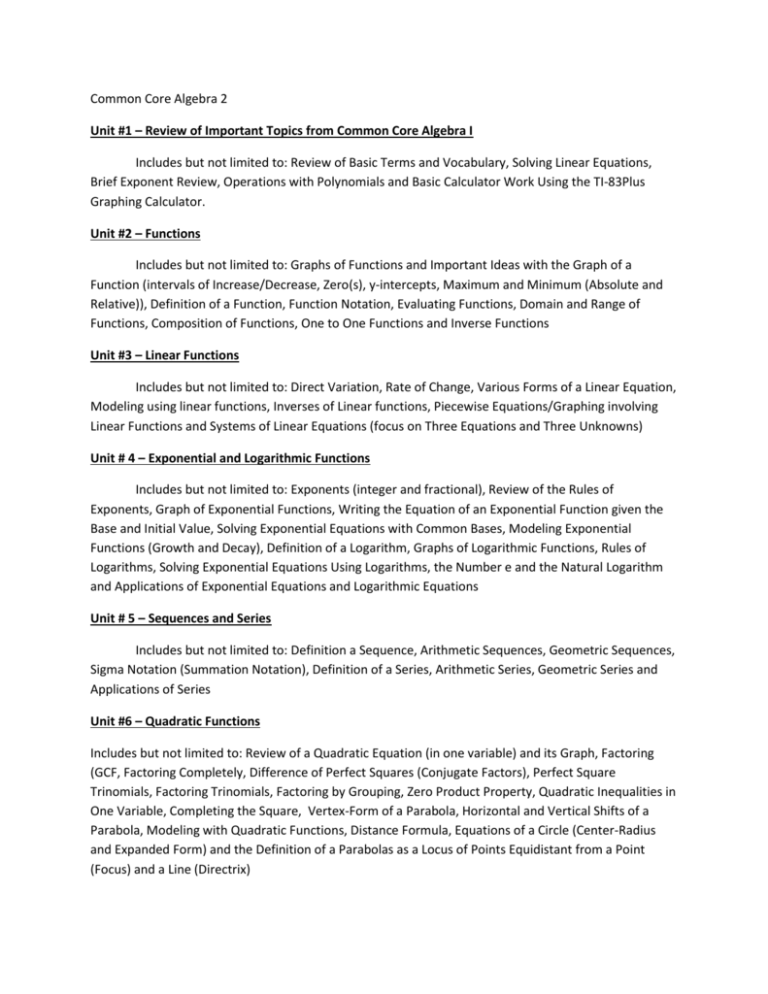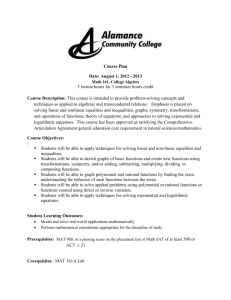Common Core Algebra 2
advertisement

Common Core Algebra 2 Unit #1 – Review of Important Topics from Common Core Algebra I Includes but not limited to: Review of Basic Terms and Vocabulary, Solving Linear Equations, Brief Exponent Review, Operations with Polynomials and Basic Calculator Work Using the TI-83Plus Graphing Calculator. Unit #2 – Functions Includes but not limited to: Graphs of Functions and Important Ideas with the Graph of a Function (intervals of Increase/Decrease, Zero(s), y-intercepts, Maximum and Minimum (Absolute and Relative)), Definition of a Function, Function Notation, Evaluating Functions, Domain and Range of Functions, Composition of Functions, One to One Functions and Inverse Functions Unit #3 – Linear Functions Includes but not limited to: Direct Variation, Rate of Change, Various Forms of a Linear Equation, Modeling using linear functions, Inverses of Linear functions, Piecewise Equations/Graphing involving Linear Functions and Systems of Linear Equations (focus on Three Equations and Three Unknowns) Unit # 4 – Exponential and Logarithmic Functions Includes but not limited to: Exponents (integer and fractional), Review of the Rules of Exponents, Graph of Exponential Functions, Writing the Equation of an Exponential Function given the Base and Initial Value, Solving Exponential Equations with Common Bases, Modeling Exponential Functions (Growth and Decay), Definition of a Logarithm, Graphs of Logarithmic Functions, Rules of Logarithms, Solving Exponential Equations Using Logarithms, the Number e and the Natural Logarithm and Applications of Exponential Equations and Logarithmic Equations Unit # 5 – Sequences and Series Includes but not limited to: Definition a Sequence, Arithmetic Sequences, Geometric Sequences, Sigma Notation (Summation Notation), Definition of a Series, Arithmetic Series, Geometric Series and Applications of Series Unit #6 – Quadratic Functions Includes but not limited to: Review of a Quadratic Equation (in one variable) and its Graph, Factoring (GCF, Factoring Completely, Difference of Perfect Squares (Conjugate Factors), Perfect Square Trinomials, Factoring Trinomials, Factoring by Grouping, Zero Product Property, Quadratic Inequalities in One Variable, Completing the Square, Vertex-Form of a Parabola, Horizontal and Vertical Shifts of a Parabola, Modeling with Quadratic Functions, Distance Formula, Equations of a Circle (Center-Radius and Expanded Form) and the Definition of a Parabolas as a Locus of Points Equidistant from a Point (Focus) and a Line (Directrix) Unit #7 – Transformations of Functions Includes but not limited to: Vertical and Horizontal Shifts of Various Functions, Reflections of a Parabola, Vertical and Horizontal Dilations of a Function (Stretching and Compressing) and Even & Odd Functions Unit #8 – Radicals and the Quadratic Formula Includes but not limited to: Domain, Range and Graphs of Square Root Functions, Solving Square Root Equations (extraneous roots), revisit Fractional Exponents as a means of discussing roots other than square roots and Quadratic Formula. Unit #9 – Complex Numbers Includes but not limited to: Definition of an Imaginary Number, Powers of I, Definition of Complex Number, Operations with Complex Numbers, Definition and Meaning of the Discriminant and Solving Quadratic Equations with Complex Roots Unit #10 – Polynomial and Rational Functions Includes but not limited to: Power Functions, Graphs and Zeros of a Polynomial, Writing Polynomial Equations, Polynomial Identities, Simplifying Rational Expressions, Operations with Rational Expressions, Solving Rational Equations, Solving Rational Inequalities, Discussion of Rational Functions, Complex Fractions, Long Division of Polynomials and Remainder Theorem Unit #11 – Trigonometric Functions Includes but not limited to: Standard Position, the meaning of Positive/Negative Angle Measures, Coterminal Angles, Reference Angles, Radian and Degree Measures of an Angle, The Unit Circle, Definition of Sine and Cosine, Pythagorean Identity, Evaluating Using Sine and Cosine, Graphs of Sine and Cosine, Frequency, Period and Amplitude of a Trig Graph, Transformations of Trig Graphs, Modeling Using Sinusoidal Graphs, the Tangent Function and Reciprocal Trig Functions. Unit #12 – Probability Includes but not limited to: Basic Terminology, Definition of Probability, Theoretical and Empirical Probabilities, Definitions of Sets/Sample Spaces, Independent and Dependent Events, Adding and Multiplying Probabilities and Conditional Probabilities Unit #13 – Statistics Includes but not limited to: Variability and Sampling, Population Parameters, Normal Distribution and Z=scores, Sample Means, Sample Proportions, Difference in Sample Means and Regression (Linear and Other)








